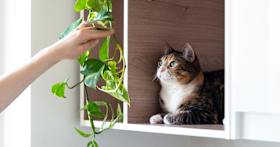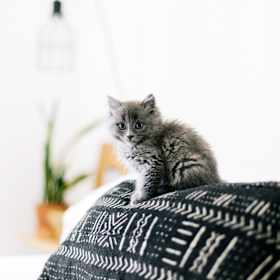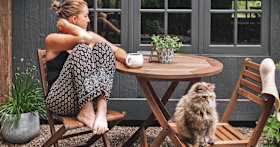Advice on How to Cat-Proof Your House
Curious about cat-proofing? Learn how to make your home safe and enjoyable for your cat.
Curious about cat-proofing? Learn how to make your home safe and enjoyable for your cat.
by Courtney Elliott, | February 18, 2025

Valerii Honcharuk / AdobeStock
Ever heard that age-old saying about curiosity and the cat? Well, it couldn’t be more true. Cats are naturally inquisitive creatures, always on the prowl for adventure and exploration. But while their curiosity is endearing, it can sometimes lead to a bit of turmoil in our homes. If you’ve ever found your favorite vase shattered or your charging cables chewed to bits, you know exactly what we mean. That’s where cat-proofing comes in — a way to strike a balance between your feline’s boundless curiosity and the safety and peace of your home.
By taking the time to cat-proof, you’re not only saving your favorite belongings but also protecting your cat from potential accidents and hazards. In this guide, we’ll walk you through the art of creating a cat-friendly and hazard-free haven, before you introduce your cat to your space. From securing cords and trash cans to providing enticing scratching posts and climbing toys, you’ll learn how to cat-proof your house in no time.
Cat-proofing your house or apartment isn’t just about preventing your new cat from turning your home into a playground of chaos — it’s also about keeping them safe and happy. Cats are notorious for their knack for discovering hidden dangers, whether it’s tangled cords, toxic plants, or precarious objects that seem like the perfect thing to knock off a shelf. Making the house safe for your cat means being aware of anything that could put them in jeopardy. Here are some things to watch out for:
Toxic houseplants: Cat-proofing houseplants is super important. Some innocent-looking houseplants can be toxic to cats, so it’s a good idea to know which ones are safe and which ones aren’t. Remove plants (or move out of reach) that are toxic to kitties.
Unsecured cords and wires: Cats are notorious cord chewers, and that can lead to some shocking experiences (literally). To cat-proof your cords, make sure cords and wires are out of reach, secured to the ground or wall, and covered to keep your cat from getting zapped or causing chaos.
Small swallowable objects: Cats have a way of finding tiny things to bat around. But those little objects can turn into big problems if your cat decides to swallow them. Keep those small items safely stashed away.
Open toilet lids: You definitely want to avoid your cat taking a dive into your toilet, so always remember to keep those lids down.
Provide plenty of hideaways: If you don’t like your cat going under your bed, you can use ready-made bed gates to block your cat from under your bed, but be sure to provide them with plenty of alternative hiding spaces.
Chemical cleaners and substances: Cats can be curious taste-testers, and that’s not a good thing when it comes to cleaning products. Store them out of reach to avoid any unpleasant surprises.
By addressing these potential hazards, you’ll be well on your way to implementing some cat-friendly house ideas and creating a safer environment for your feline friend.

Lupe Rodríguez / Stocksy
Now that you’re aware of the possible dangers that lurk in your home, it’s time to get cat-proofing. Here are the basics of making your house a safe and welcoming environment for your newly adopted cat.
Cats have a way of turning small and seemingly irresistible objects into playthings. Protect your cat from choking hazards by keeping these items out of reach. After all, we want your cat to have fun, not play a game of “swallow the thing now and ask questions later.”
Cats can be little culinary explorers, but that can lead to trouble when they nibble on things like toxic plants, chocolate, or cleaning supplies. Make sure to keep these out of paws’ reach so your cat can stick to their kibble and treats.
Cats are natural climbers and love to perch in high places. To prevent any accidental acrobatics, secure tall furniture and bookshelves with anti-tip furniture anchors. These anchors secure your furniture to a stud, preventing movement when your cat jumps around. Trust us; your cat will appreciate having a safe lookout spot.
If you’re looking for curtains or blinds that cats can’t destroy, you’ll have a tough time because, after all, cats are just that — cats. However, vertical blinds and stronger, larger wooden blinds are the most common cat-friendly recommendations.
Loose cords (such as those for blinds) and electrical wires can be irresistible chew toys for your curious kitty, but they’re not safe to snack on. Besides being electrical hazards, cords are also suffocation hazards. Keep them out of reach or invest in some protective cord coverings to avoid any trouble — for both you and your cat.
Bored cats can become mischievous cats, and that’s where stimulation and cat scratching posts come to the rescue. These are essential tools to keep your feline entertained and away from your furniture. A cat with their own scratching post is a happy cat, and a happy cat makes for a happy home.
Kittens have an uncanny ability to turn even the simplest household items into playthings. To keep your kitten safe and your home intact, here are some kitten-proofing tips that’ll have you ready for their arrival.
Use gates to block cats out of certain rooms: Think of gates as “keep out” signs for your kitten’s safety. Block off areas where you’d rather your kitten not explore — like rooms with fragile decor or valuable items.
Supervise regularly: This one’s a golden rule of kitten parenting. Just like toddlers, kittens need constant supervision. Keep an eye on them, especially when they’re exploring new territories.
Provide your kitten with a safe way to get on or off the couch: Your kitten’s desire to reach new heights can be satisfied with some strategically placed kitty steps or a low platform. This way, they can practice their acrobatics without any injuries.
Begin training early: Teaching your kitten basic commands can go a long way in keeping them out of trouble. Start early with gentle training and positive reinforcement to create a well-behaved cat.
If you really want to cat-proof a house, you’re going to have to go room by room — you’d be surprised at all the hidden spots your clever cat will want to explore.
The kitchen is like a treasure trove of smells and tastes for your cat. It’s also a place where they can potentially get into trouble. Here’s how to make your kitchen safe for your cat:
Secure trash cans to prevent scavenging adventures.
Keep toxic foods out of reach and away from counters.
Store sharp objects and kitchen tools safely.
Be mindful of hot stovetops and boiling pots.
Your living room is the heart of your home, where relaxation meets entertainment. But for your cat, it’s a vast playground with lots to explore. To create a cat-friendly living space, consider these tips:
Secure or cover cords and wires to prevent chewing.
Keep fragile decor and knick-knacks out of reach.
Choose pet-friendly furniture, and use slipcovers if needed.
Create cozy cat nooks with comfy blankets and cushions.
Bedrooms are a favorite hideaway for cats seeking some peace and quiet. Make sure this space remains a serene sanctuary for you both with these ideas:
Keep small items and jewelry safely stored in drawers.
Use a doorstop or door wedge to avoid curious cats in closed doors.
Check for hiding spots under the bed and behind furniture.
Place plants and flowers out of reach.
Bathrooms may seem like an unlikely place for cat adventures, but they can pose some risks. Ensure your bathroom stays cat-friendly with these suggestions:
Keep toilet lids closed to prevent accidental plunges.
Store medications and toiletries securely in cabinets.
Be mindful of curling irons and hairdryers plugged in.
Provide a non-slip bath mat to avoid accidents on slippery surfaces.
For cat parents fortunate enough to have outdoor spaces, it’s crucial to make them safe for your feline’s escapades. Here’s how to create a secure yard for your cat:
Install a cat-proof fence to keep your cat within the yard.
Create shaded areas to protect your cat from the sun.
Avoid toxic plants and chemicals in your gardening.
Provide outdoor cat toys and supervision.
Remember, kittens grow quickly and even adult cats need change, so you’ll need to regularly reevaluate your cat-proofing efforts as they get older. With a little preparation and lots of patience, you’ll turn your home into a safe, happy, and entertaining retreat for your new family member.
To keep your cat from scratching furniture and other items, invest in scratching posts and provide your cat with plenty of appropriate alternatives. Cats have a natural urge to scratch to sharpen their claws, so giving them a designated space for this can work wonders. You can also use cat-friendly deterrents such as double-sided tape or a pet-friendly spray on your furniture. Cats usually don’t enjoy sticky surfaces or unusual scents. Regular nail trimming can also help reduce the damage they can do. If you’re not comfortable doing it yourself, consult your vet or a professional groomer.
If your cat has already damaged something in your house, first check that your cat is OK. Once you confirm that they aren’t in any danger, assess the damage and decide if it’s repairable. Sometimes, a little DIY fix can do the trick. Clean up the mess thoroughly with cat-friendly cleaning products to remove any odors or stains. Then, put in the time to cat-proof your house to prevent future incidents.
Hidden Dangers in the Kitchen: Common Foods Toxic to Dogs and Cats

Courtney Elliott, a proud Cleveland native living in Manhattan, blends her decade of writing and editing expertise with her unshakable devotion as a pet parent to her French Bulldog, Gus. When she’s not at her desk, you’ll find her frolicking in Central Park or engrossed in a good book at a local coffee shop.

Adoption Advice

Adoption Advice

Adoption Advice

Behavior & Training
Is your cat hiding? Don’t worry, it’s totally normal. Here’s how to help them adjust.

Adoption Advice
In the process of adopting a new kitten? Learn more about how you should introduce your adopted friend to their new home.

Adoption Advice
Bringing home a cat? Here’s what you’ll wish you knew sooner.

Adoption Advice
Are you ready to bring a new cat home? These tips will help you prep your kid for their new BFF.

Adoption Advice
Cat introduction process not going well? Here’s what might be causing the issues.

Adoption Advice
Don’t want your adoption application to get rejected? Learn how to increase the chances of an approval.